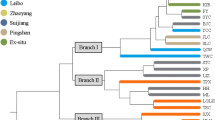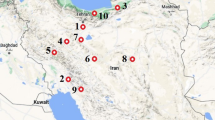Abstract
Genetic diversity of seven cultivated populations of Codonopsis pilosula Nannf. from Longxi County, Gansu Province of China was estimated using randomly amplified polymorphic DNA (RAPD) markers. The 17 selected RAPD primers amplified 205 polymorphic bands out of a total of 235 (87.2%). Nei’s gene-diversity statistics and population differentiation parameters based on AMOVA analysis indicated that the cultivated C. pilosula populations remained a high level of genetic diversity with Hs = 0.299 and I = 0.450. A greater proportion of genetic diversity was found within (77%) rather than among (23%) the populations. In addition, we also detected that populations from different altitudes had a considerable genetic differentiation after 40 years of cultivation at the same site. Populations from higher altitude had lower genetic diversity than those from lower altitude. Our results suggested that irregular and sparse cultivation practices, i.e., random collecting, preserving, and planting seeds of the medicinal species without deliberate selection, might be an efficient way to conserve genetic resources of medicinal plants, in addition to their effective uses.
Similar content being viewed by others
References
Bauert MR (1996) Genetic diversity and ecotypic differentiation in arctic and alpine population of Polygonum viviparum. Arct Alp Res 28:190–195
Chung MG, Chung MY, Epperson BK (2001) Conservation genetics of an endangered herb, Hanabusaya asiatica (Campanulaceae). Plant Biol 3:42–49
Diggle PK, Lower S, Ranker TA (1998) Clonal diversity in alpine populations of Polygonum viviparum (Polygonaceae). Int J Plant Sci 159:606–615
Galen C, Shore JS, Deyoe H (1991) Ecotypic divergence in alpine Polemonium viscosum: genetic structure, quantitative variation and local adaptation. Evolution 45:1218–1228
Ge S, Wang KQ, Hong DY, Zhang WH, Zu YG (1999) Comparison of genetic diversities in the endangered Adenophora lobophylla and its widespread congener, A. potaninii. Conserv Biol 13:509–513
Gehring JL, Linhart YB (1992) Population structure and genetic differentiation in native and introduced populations of Leschampsia caespitosa (Poaceae) in the Colorado alpine. Am J Bot 79:1337–1343
Guo HB, Ke WD, Li SM, Peng J (2004) Cluster analysis of Nelumbo accessions based on RAPD markers. J Plant Genet Res 5:328–332
Hamrick JL, Godt MJW (1989) Allozyme diversity in plant species. In: Brown AHD, Clegg MT, Kahler AL, Weir BS (eds) Plant population genetics, breeding and genetic resources. Sinauer Associates, Massachusetts, pp 43–46
Hong DY, Lian YS, Shen LD (1983). Codonopsis Wall. In: Editorial Committee of China Flora (eds) China Flora, vol 73 (2). Science Press, Beijing, pp 32–69
Li J (2001) Pollination rates and seed set in Codonopsis pilosula (Franch.) Nannf. J Qufu Norm Univ 27:74–75
Longxi society of Chinese medicinal materials. (2005). The origins of Chinese materials. Retrieved July 1 from http://www.xbzyc.com
Mill LS, Allendorf FA (1996) The one-migrant-per-generation rule in conservation and management. Conserv Biol. 10:1509–1518
Miller MP (1998) AMOVA-PREP, a program for the preparatition of AMOVA input files from dominant marder raw data (release 1.01). Department of Biology Science Northern Arizona University, Flagstaff
Nei M (1978) Estimation of average heterozygosity and genetic distance from a small number of individuals. Genetics 89:583–590
Nybom H, Bartish V (2000) Effects of life history traits and sampling strategies on genetic diversities estimates obtained with RAPD markers in plants. Perspect Plant Ecol Evol Syst 3:93–114
Oiki S, Kawahara T, Inoue K, Ohara M, Maki M (2001) Random amplified polymorphic DNA (RAPD) variation among populations of the insular endemic plant Campanula microdonta (Campanulaceae). Ann Bot 87:661–667
Reisch C, Anke A, Röhl M (2005) Molecular variation within and between ten populations of Primula farinose (Primulaceae) along an altitudinal gradient in the northern Alps. Basic Appl Ecol 6:35–45
Robin AB, Tom AR (2000) Genetic diversity in alpine and foothill populations of Campanula rotundifolia (Campanulaceae). Int J Plant Sci 161:403–411
Stanton ML, Galen C, Shore J (1997) Population structure along a steep environmental gradient: consequences of flowering time and habitat variation in the snow buttercup, Ranunculus adoneus. Evolution 51:79–94
Yeh FC, Young RC, Boyle T (1999) Microsoft Window-based freeware for population genetic analysis (POPGENE, ver. 1.31). http://www.ftp.microsoft.com/softlib/mslfiles/hpgl.exe
Zhang YB, Ngan FN, Wang ZT, Ng TB, But PPH, Shaw PC (1999) Random primered polymerase chain reaction differentiates Codonopsis pilosula from different localities. Planta Med 65:157–160
Zhu HY, Zhao RN (1996) Advance in medicinal plant cultivation in China. J Lanzhou Med Coll 22:70–71
Zhu XX, Zhu L (2004) differentiate root of Codonopsis pilosula and Panax ginseng. Chin J Prac Chin Mod Med 4:1207–1208
Acknowledgements
This work was supported by grants from Shanghai Commission of Science and Technology (Grant No. 03DZ19547 and 03DZ19532). We appreciate Dr. Song Zhi-Ping of Fudan University for providing valuable comments on the manuscript.
Author information
Authors and Affiliations
Corresponding author
Rights and permissions
About this article
Cite this article
Guo, H., Lu, B., Wu, Q. et al. Abundant genetic diversity in cultivated Codonopsis pilosula populations revealed by RAPD polymorphisms. Genet Resour Crop Evol 54, 917–924 (2007). https://doi.org/10.1007/s10722-006-9163-8
Received:
Accepted:
Published:
Issue Date:
DOI: https://doi.org/10.1007/s10722-006-9163-8




